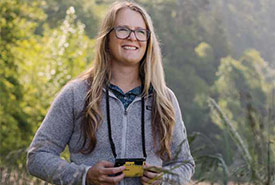Shutterbug

Jennifer Heron (Photo by Albert Law)
Invertebrate conservation biologist Jennifer Heron loves nothing more than taking hundreds of photos of whatever species she comes across
Field work is one of the most enjoyable parts of my job. As an invertebrate conservation biologist, I’m fortunate to have had the opportunity to be part of field studies across Canada. When I head into the field, one of my backpack essentials is my small, bright yellow waterproof (and drop-proof) point-and-shoot digital camera. I tend to take hundreds of photos throughout a field work day, and while my focus is on invertebrates, I take photos of all the species I can at a site.
Precautions to limit the spread of COVID-19 have meant that much of my field work has been postponed these past seasons, but with this new-found time, I’ve keenly shifted my focus to sorting through the thousands of photos I’ve taken over the years. Some groups, like butterflies, tiger beetles, grasshoppers and dragonflies, I am able to identify more easily from my photographs, but other groups are beyond my expertise. With the help of the iNaturalist.ca community, I’ve started to identify many of the species in my photos. iNaturalist members have also offered tips on species’ key identifying features to help maximize the chances of positively identifying my photos. Now that spring is upon us, I’m keen to photo-document as much as I can of the fauna and flora in my local area.
This story originally appeared in the summer 2021 issue of the Nature Conservancy of Canada Magazine. To learn more about how you can receive the magazine, click here.
Explore additional content from our summer issue here >




